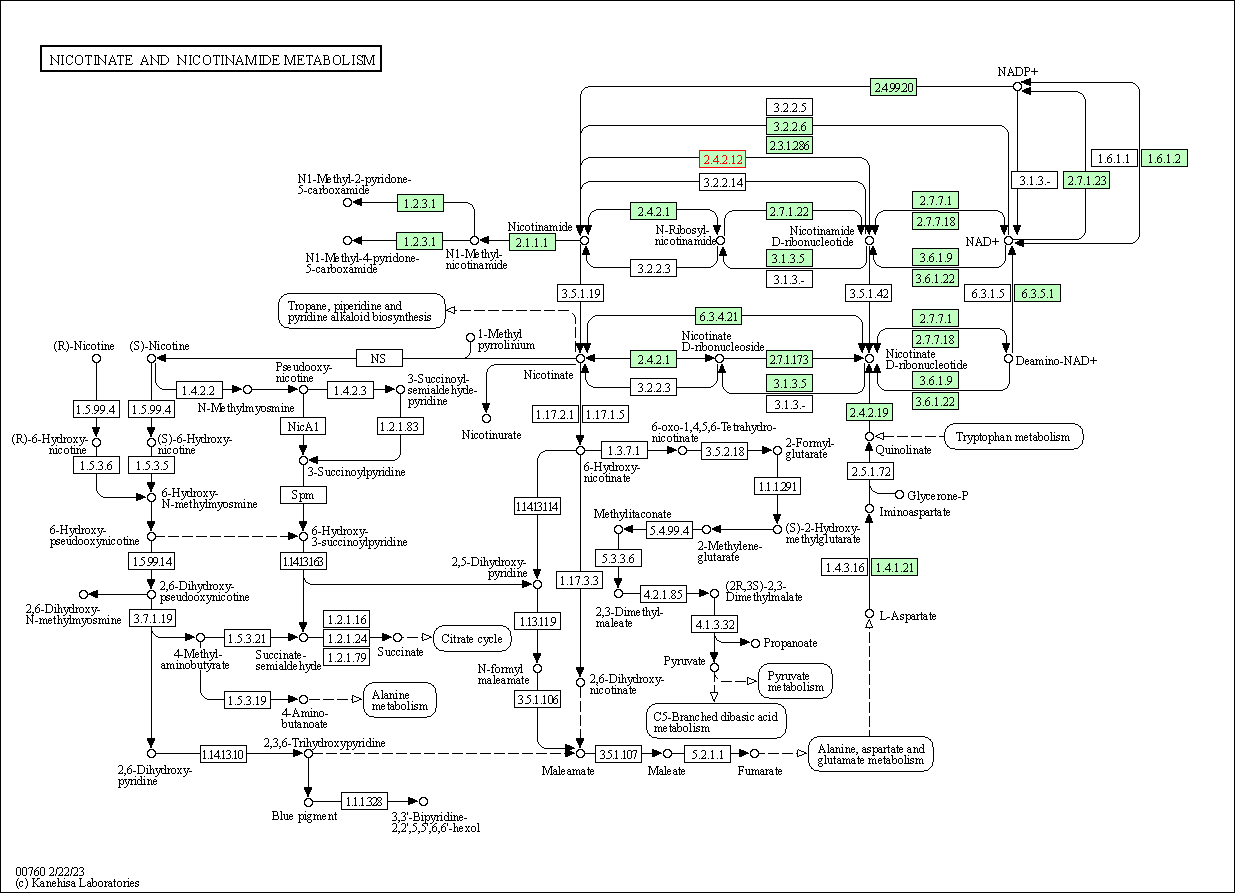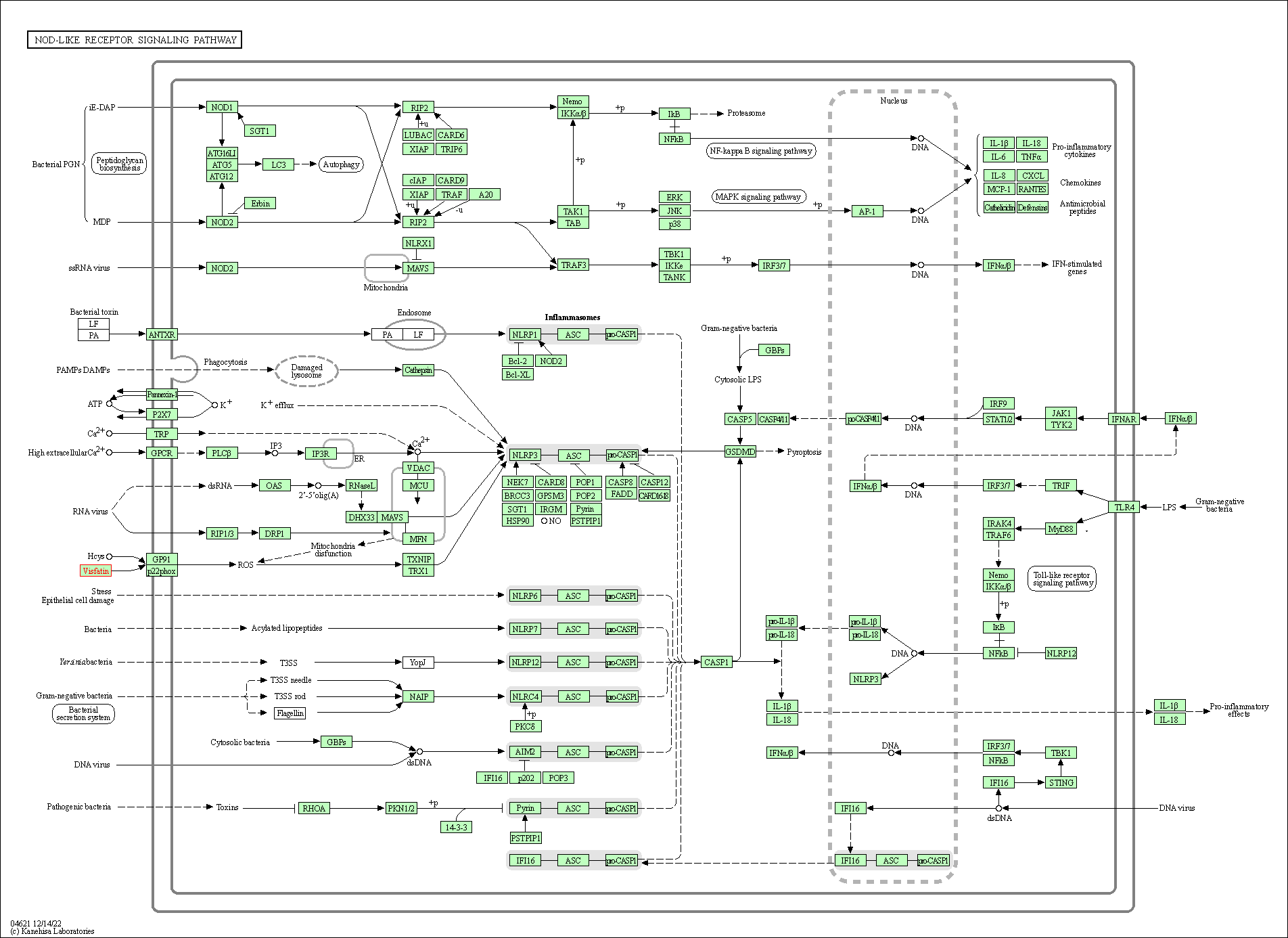Target Information
| Target General Information | Top | |||||
|---|---|---|---|---|---|---|
| Target ID |
T54582
(Former ID: TTDI02132)
|
|||||
| Target Name |
Nicotinamide phosphoribosyltransferase (NAMPT)
|
|||||
| Synonyms |
Visfatin; PreBcell colonyenhancing factor 1; PreB cellenhancing factor; Pre-B-cell colony-enhancing factor 1; Pre-B cell-enhancing factor; PBEF1; PBEF; Nampt; NAmPRTase
Click to Show/Hide
|
|||||
| Gene Name |
NAMPT
|
|||||
| Target Type |
Clinical trial target
|
[1] | ||||
| Disease | [+] 3 Target-related Diseases | + | ||||
| 1 | Leukaemia [ICD-11: 2A60-2B33] | |||||
| 2 | Lymphoma [ICD-11: 2A80-2A86] | |||||
| 3 | Solid tumour/cancer [ICD-11: 2A00-2F9Z] | |||||
| Function |
It is the rate limiting component in the mammalian NAD biosynthesis pathway. The secreted form behaves both as a cytokine with immunomodulating properties and an adipokine with anti-diabetic properties, it has no enzymatic activity, partly because of lack of activation by ATP, which has a low level in extracellular space and plasma. Plays a role in the modulation of circadian clock function. NAMPT-dependent oscillatory production of NAD regulates oscillation of clock target gene expression by releasing the core clock component: CLOCK-ARNTL/BMAL1 heterodimer from NAD-dependent SIRT1-mediated suppression. Catalyzes the condensation of nicotinamide with 5-phosphoribosyl-1-pyrophosphate to yield nicotinamide mononucleotide, an intermediate in the biosynthesis of NAD.
Click to Show/Hide
|
|||||
| BioChemical Class |
Glycosyltransferases
|
|||||
| UniProt ID | ||||||
| EC Number |
EC 2.4.2.12
|
|||||
| Sequence |
MNPAAEAEFNILLATDSYKVTHYKQYPPNTSKVYSYFECREKKTENSKLRKVKYEETVFY
GLQYILNKYLKGKVVTKEKIQEAKDVYKEHFQDDVFNEKGWNYILEKYDGHLPIEIKAVP EGFVIPRGNVLFTVENTDPECYWLTNWIETILVQSWYPITVATNSREQKKILAKYLLETS GNLDGLEYKLHDFGYRGVSSQETAGIGASAHLVNFKGTDTVAGLALIKKYYGTKDPVPGY SVPAAEHSTITAWGKDHEKDAFEHIVTQFSSVPVSVVSDSYDIYNACEKIWGEDLRHLIV SRSTQAPLIIRPDSGNPLDTVLKVLEILGKKFPVTENSKGYKLLPPYLRVIQGDGVDINT LQEIVEGMKQKMWSIENIAFGSGGGLLQKLTRDLLNCSFKCSYVVTNGLGINVFKDPVAD PNKRSKKGRLSLHRTPAGNFVTLEEGKGDLEEYGQDLLHTVFKNGKVTKSYSFDEIRKNA QLNIELEAAHH Click to Show/Hide
|
|||||
| 3D Structure | Click to Show 3D Structure of This Target | PDB | ||||
| HIT2.0 ID | T46J84 | |||||
| Drugs and Modes of Action | Top | |||||
|---|---|---|---|---|---|---|
| Clinical Trial Drug(s) | [+] 1 Clinical Trial Drugs | + | ||||
| 1 | Daporinad | Drug Info | Phase 2 | leukaemia | [1], [2] | |
| Mode of Action | [+] 1 Modes of Action | + | ||||
| Inhibitor | [+] 1 Inhibitor drugs | + | ||||
| 1 | Daporinad | Drug Info | [1] | |||
| Cell-based Target Expression Variations | Top | |||||
|---|---|---|---|---|---|---|
| Cell-based Target Expression Variations | ||||||
| Drug Binding Sites of Target | Top | |||||
|---|---|---|---|---|---|---|
| Ligand Name: Nicotinamide | Ligand Info | |||||
| Structure Description | Crystal structure of Human NMPRTase complexed with nicotinamide | PDB:2E5D | ||||
| Method | X-ray diffraction | Resolution | 2.00 Å | Mutation | No | [5] |
| PDB Sequence |
EFNILLATDS
17 YKVTHYKQYP27 PNTSKVYSYF37 ECREKKYEET57 VFYGLQYILN67 KYLKGKVVTK 77 EKIQEAKDVY87 KEHFQDDVFN97 EKGWNYILEK107 YDGHLPIEIK117 AVPEGFVIPR 127 GNVLFTVENT137 DPECYWLTNW147 IETILVQSWY157 PITVATNSRE167 QKKILAKYLL 177 ETSGNLDGLE187 YKLHDFGYRG197 VSSQETAGIG207 ASAHLVNFKG217 TDTVAGLALI 227 KKYYGTKDPV237 PGYSVPAAEH247 STITAWGKDH257 EKDAFEHIVT267 QFSSVPVSVV 277 SDSYDIYNAC287 EKIWGEDLRH297 LIVSRSTQAP307 LIIRPDSGNP317 LDTVLKVLEI 327 LGKKFPVTEN337 SKGYKLLPPY347 LRVIQGDGVD357 INTLQEIVEG367 MKQKMWSIEN 377 IAFGSGGGLL387 QKLTRDLLNC397 SFKCSYVVTN407 GLGINVFKDP417 VADPNKRSKK 427 GRLSLHRTPA437 GNFVTLEEGK447 GDLEEYGQDL457 LHTVFKNGKV467 TKSYSFDEIR 477 KNAQLN
|
|||||
|
|
||||||
| Ligand Name: Diazoxide | Ligand Info | |||||
| Structure Description | Fragment-based Identification of Amides Derived From trans-2-(Pyridin-3-yl)cyclopropanecarboxylic Acid as Potent Inhibitors of Human Nicotinamide Phosphoribosyltransferase (NAMPT) | PDB:4LV9 | ||||
| Method | X-ray diffraction | Resolution | 1.81 Å | Mutation | No | [6] |
| PDB Sequence |
EFNILLATDS
17 YKVTHYKQYP27 PNTSKVYSYF37 ECREKKYEET57 VFYGLQYILN67 KYLKGKVVTK 77 EKIQEAKDVY87 KEHFQDDVFN97 EKGWNYILEK107 YDGHLPIEIK117 AVPEGFVIPR 127 GNVLFTVENT137 DPECYWLTNW147 IETILVQSWY157 PITVATNSRE167 QKKILAKYLL 177 ETSGNLDGLE187 YKLHDFGYRG197 VSSQETAGIG207 ASAHLVNFKG217 TDTVAGLALI 227 KKYYGTKDPV237 PGYSVPAAEH247 STITAWGKDH257 EKDAFEHIVT267 QFSSVPVSVV 277 SDSYDIYNAC287 EKIWGEDLRH297 LIVSRSTQAP307 LIIRPDSGNP317 LDTVLKVLEI 327 LGKKFPVTEN337 SKGYKLLPPY347 LRVIQGDGVD357 INTLQEIVEG367 MKQKMWSIEN 377 IAFGSGGGLL387 QKLTRDLLNC397 SFKCSYVVTN407 GLGINVFKDP417 VADPNKRSKK 427 GRLSLHRTPA437 GNFVTLEEGK447 GDLEEYGQDL457 LHTVFKNGKV467 TKSYSFDEIR 477 KNAQLNIEL
|
|||||
|
|
||||||
| Click to View More Binding Site Information of This Target with Different Ligands | ||||||
| Different Human System Profiles of Target | Top |
|---|---|
|
Human Similarity Proteins
of target is determined by comparing the sequence similarity of all human proteins with the target based on BLAST. The similarity proteins for a target are defined as the proteins with E-value < 0.005 and outside the protein families of the target.
A target that has fewer human similarity proteins outside its family is commonly regarded to possess a greater capacity to avoid undesired interactions and thus increase the possibility of finding successful drugs
(Brief Bioinform, 21: 649-662, 2020).
Human Tissue Distribution
of target is determined from a proteomics study that quantified more than 12,000 genes across 32 normal human tissues. Tissue Specificity (TS) score was used to define the enrichment of target across tissues.
The distribution of targets among different tissues or organs need to be taken into consideration when assessing the target druggability, as it is generally accepted that the wider the target distribution, the greater the concern over potential adverse effects
(Nat Rev Drug Discov, 20: 64-81, 2021).
Human Pathway Affiliation
of target is determined by the life-essential pathways provided on KEGG database. The target-affiliated pathways were defined based on the following two criteria (a) the pathways of the studied target should be life-essential for both healthy individuals and patients, and (b) the studied target should occupy an upstream position in the pathways and therefore had the ability to regulate biological function.
Targets involved in a fewer pathways have greater likelihood to be successfully developed, while those associated with more human pathways increase the chance of undesirable interferences with other human processes
(Pharmacol Rev, 58: 259-279, 2006).
Biological Network Descriptors
of target is determined based on a human protein-protein interactions (PPI) network consisting of 9,309 proteins and 52,713 PPIs, which were with a high confidence score of ≥ 0.95 collected from STRING database.
The network properties of targets based on protein-protein interactions (PPIs) have been widely adopted for the assessment of target’s druggability. Proteins with high node degree tend to have a high impact on network function through multiple interactions, while proteins with high betweenness centrality are regarded to be central for communication in interaction networks and regulate the flow of signaling information
(Front Pharmacol, 9, 1245, 2018;
Curr Opin Struct Biol. 44:134-142, 2017).
Human Similarity Proteins
Human Tissue Distribution
Human Pathway Affiliation
Biological Network Descriptors
|
|
|
There is no similarity protein (E value < 0.005) for this target
|
|
Note:
If a protein has TS (tissue specficity) scores at least in one tissue >= 2.5, this protein is called tissue-enriched (including tissue-enriched-but-not-specific and tissue-specific). In the plots, the vertical lines are at thresholds 2.5 and 4.
|
| KEGG Pathway | Pathway ID | Affiliated Target | Pathway Map |
|---|---|---|---|
| Nicotinate and nicotinamide metabolism | hsa00760 | Affiliated Target |

|
| Class: Metabolism => Metabolism of cofactors and vitamins | Pathway Hierarchy | ||
| NOD-like receptor signaling pathway | hsa04621 | Affiliated Target |

|
| Class: Organismal Systems => Immune system | Pathway Hierarchy | ||
| Degree | 15 | Degree centrality | 1.61E-03 | Betweenness centrality | 1.14E-03 |
|---|---|---|---|---|---|
| Closeness centrality | 2.07E-01 | Radiality | 1.36E+01 | Clustering coefficient | 9.52E-02 |
| Neighborhood connectivity | 9.73E+00 | Topological coefficient | 1.12E-01 | Eccentricity | 11 |
| Download | Click to Download the Full PPI Network of This Target | ||||
| Chemical Structure based Activity Landscape of Target | Top |
|---|---|
| Drug Property Profile of Target | Top | |
|---|---|---|
| (1) Molecular Weight (mw) based Drug Clustering | (2) Octanol/Water Partition Coefficient (xlogp) based Drug Clustering | |
|
|
||
| (3) Hydrogen Bond Donor Count (hbonddonor) based Drug Clustering | (4) Hydrogen Bond Acceptor Count (hbondacc) based Drug Clustering | |
|
|
||
| (5) Rotatable Bond Count (rotbonds) based Drug Clustering | (6) Topological Polar Surface Area (polararea) based Drug Clustering | |
|
|
||
| "RO5" indicates the cutoff set by lipinski's rule of five; "D123AB" colored in GREEN denotes the no violation of any cutoff in lipinski's rule of five; "D123AB" colored in PURPLE refers to the violation of only one cutoff in lipinski's rule of five; "D123AB" colored in BLACK represents the violation of more than one cutoffs in lipinski's rule of five | ||
| Co-Targets | Top | |||||
|---|---|---|---|---|---|---|
| Co-Targets | ||||||
| Target Poor or Non Binders | Top | |||||
|---|---|---|---|---|---|---|
| Target Poor or Non Binders | ||||||
| Target Regulators | Top | |||||
|---|---|---|---|---|---|---|
| Target-regulating microRNAs | ||||||
| Target Profiles in Patients | Top | |||||
|---|---|---|---|---|---|---|
| Target Expression Profile (TEP) | ||||||
| Target Affiliated Biological Pathways | Top | |||||
|---|---|---|---|---|---|---|
| BioCyc | [+] 1 BioCyc Pathways | + | ||||
| 1 | NAD salvage | |||||
| KEGG Pathway | [+] 2 KEGG Pathways | + | ||||
| 1 | Nicotinate and nicotinamide metabolism | |||||
| 2 | Metabolic pathways | |||||
| NetPath Pathway | [+] 3 NetPath Pathways | + | ||||
| 1 | IL2 Signaling Pathway | |||||
| 2 | IL1 Signaling Pathway | |||||
| 3 | TCR Signaling Pathway | |||||
| Pathwhiz Pathway | [+] 1 Pathwhiz Pathways | + | ||||
| 1 | Nicotinate and Nicotinamide Metabolism | |||||
| Reactome | [+] 1 Reactome Pathways | + | ||||
| 1 | BMAL1:CLOCK,NPAS2 activates circadian gene expression | |||||
| WikiPathways | [+] 3 WikiPathways | + | ||||
| 1 | Adipogenesis | |||||
| 2 | Metabolism of water-soluble vitamins and cofactors | |||||
| 3 | Circadian Clock | |||||
| References | Top | |||||
|---|---|---|---|---|---|---|
| REF 1 | Anticancer agent CHS-828 inhibits cellular synthesis of NAD. Biochem Biophys Res Commun. 2008 Mar 21;367(4):799-804. | |||||
| REF 2 | URL: http://www.guidetopharmacology.org Nucleic Acids Res. 2015 Oct 12. pii: gkv1037. The IUPHAR/BPS Guide to PHARMACOLOGY in 2016: towards curated quantitative interactions between 1300 protein targets and 6000 ligands. (Ligand id: 7745). | |||||
| REF 3 | The small molecule GMX1778 is a potent inhibitor of NAD+ biosynthesis: strategy for enhanced therapy in nicotinic acid phosphoribosyltransferase 1-... Mol Cell Biol. 2009 Nov;29(21):5872-88. | |||||
| REF 4 | ClinicalTrials.gov (NCT03921879) Safety and Efficacy of OT-82 in Participants With Relapsed or Refractory Lymphoma. U.S. National Institutes of Health. | |||||
| REF 5 | Structure and reaction mechanism of human nicotinamide phosphoribosyltransferase. J Biochem. 2010 Jan;147(1):95-107. | |||||
| REF 6 | Identification of amides derived from 1H-pyrazolo[3,4-b]pyridine-5-carboxylic acid as potent inhibitors of human nicotinamide phosphoribosyltransferase (NAMPT). Bioorg Med Chem Lett. 2013 Oct 15;23(20):5488-97. | |||||
If You Find Any Error in Data or Bug in Web Service, Please Kindly Report It to Dr. Zhou and Dr. Zhang.

